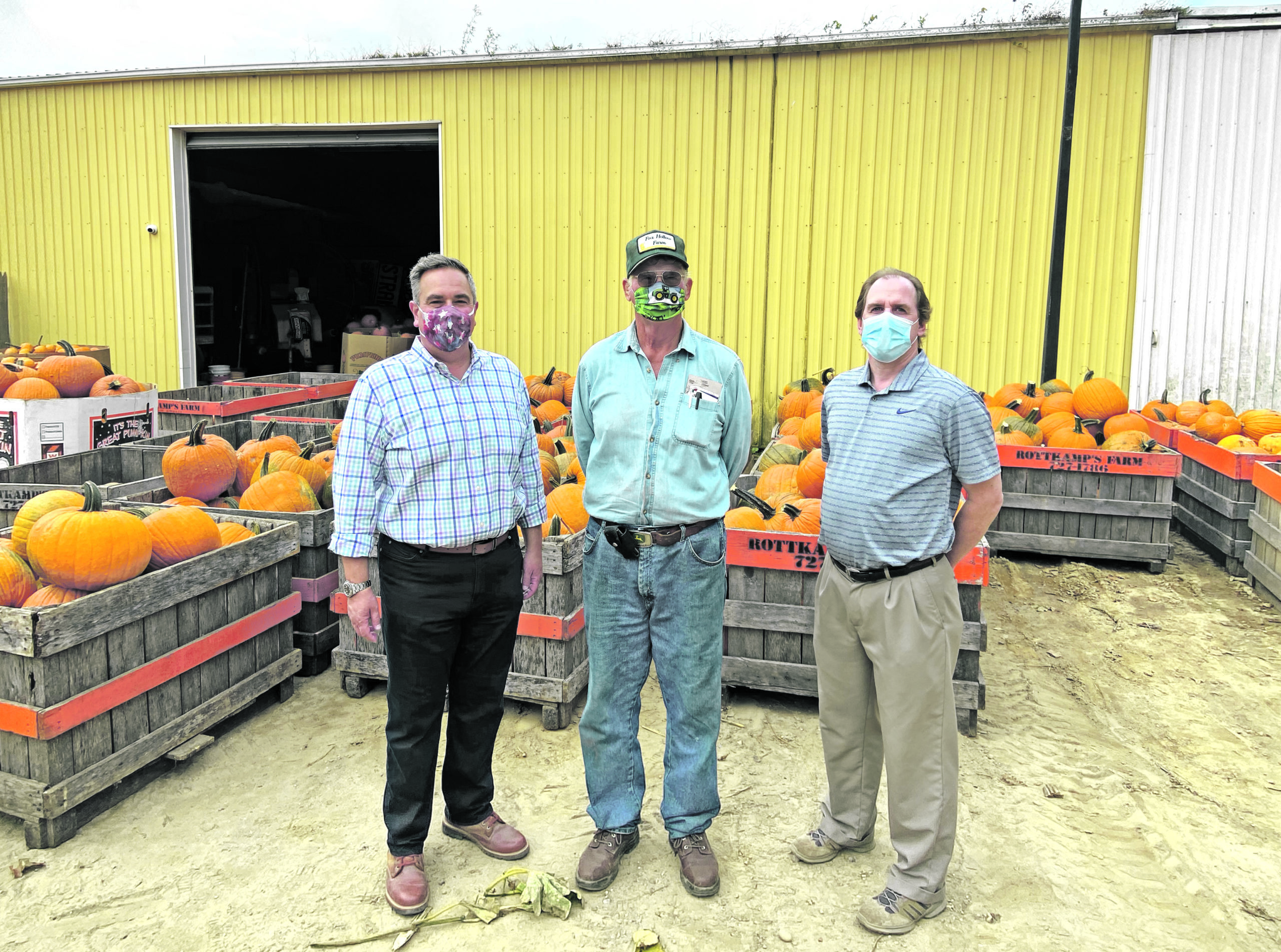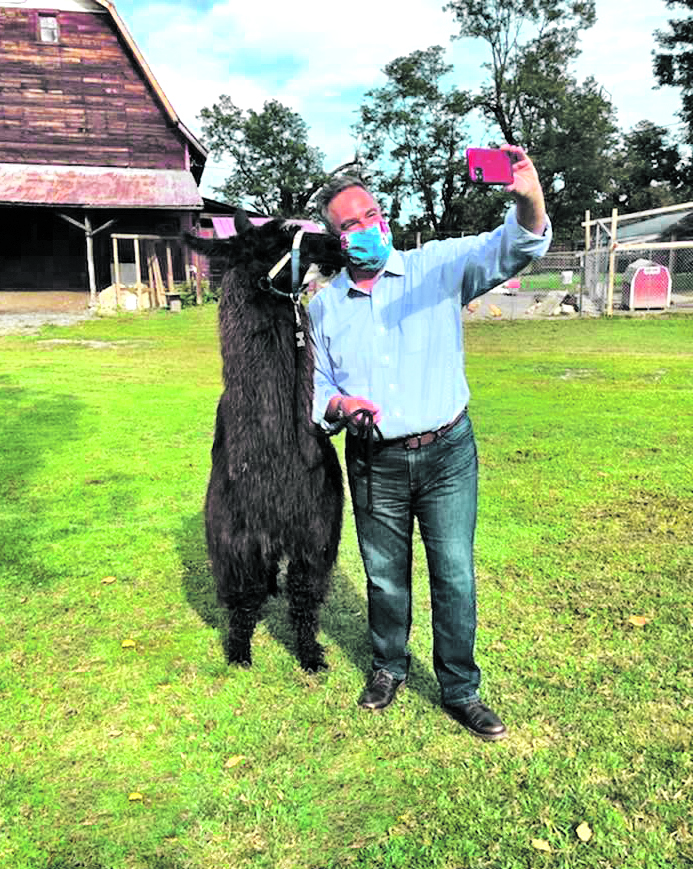Reflections from a New York State Farm Tour
Senator George M. Borrello shares the dedication and innovation define today’s farmers.

Long Island’s Suffolk County is the state’s largest pumpkin producer. During my visit to the region, I had the opportunity to visit with Jeff Rottkamp and his family, who run Rottkamp’s Fox Hollow Farm, a 230-acre predominately vegetable farm. I am pictured here with Jeff Rottkamp and Long Island Farm Bureau Administrative Director Rob Carpenter.
Image courtesy of the New York State Senate
In the corner of New York State where I grew up, farming was and still is part of the fabric of daily life. Both of my grandfathers were concord grape farmers, which gave me the opportunity to experience the seasonal rhythm of the farm, the attachment to the land, and deep-rooted sense of independence. Family farming also means operating a small business. My careers in both business and public service draw on the values they instilled in me: working hard, appreciating what you have, and serving your community.
That is why when I was presented with the opportunity to serve as the Ranking Member on the Senate’s Agriculture Committee, I embraced that honor. Our region is blessed with an abundance of farms that drive our economy and enrich our quality of life. However, recent years have seen New York farmers struggling with many challenges, including market shifts, high property taxes, labor shortages and harmful state regulations. The base cost of operating a farm in New York was already far above the national average. Then came COVID-19 and its devastation of national and global supply chains, leaving farmers with huge losses.
Against this backdrop, I felt it was important for me to get a firsthand perspective on the industry. With invaluable organizational assistance from the New York Farm Bureau, I embarked on a statewide farm tour. Altogether, I logged over 3,000 miles (more than I would cover if I drove from my home to Miami and back!) visiting farms in diverse regions including the Hudson Valley, the Mohawk Valley and Catskill Region, Long Island, the furthest reaches of the North Country, and Central New York. This is in addition to the many farms I’ve visited in my senate district.
I came away from the tour with a better understanding of the diverse characteristics and strengths of each region. Yet, I also came away from it incredibly inspired by the resilience, innovation and dedication that our farmers are investing in their farms and communities. This approach has helped them persevere through a multitude of obstacles and encouraged the overall diversification of the industry.
Below are aspects of my tour that challenged assumptions and encouraged me on the state of farming in New York.
New Farmers
While it is true that the average age of today’s farmers (57) is older than in generations past, I was encouraged by the fact that many of those I met in my travels were first-generation farmers, some of whom left the corporate world to pursue their passion. This was especially true in the Hudson Valley, which has had a significant influx of new farmers. Some are young idealistic entrepreneurs, drawn to the promise of self-sufficiency and authenticity. Others are pursuing the growing opportunities in the emerging ‘real food’ economy, which is fueled by proximity to the New York City area. No matter the reason, this infusion is positive for the industry and the region, and is supported by a host of organizations dedicated to training and connecting new farmers, including the dedicated professionals at Cornell Cooperative Extension and Cornell CALS and its many support initiatives.
Also helping to grow the next generation of farmers are forward-thinking programs like Ag Academy, an educational program for high school juniors and seniors offered by St. Lawrence-Lewis BOCES and the Cornell Cooperative Extension of St. Lawrence County. The program marries agricultural science, business management and hands-on experience at the Learning Farm, a working farm and educational facility. There’s even live-stream culinary classes broadcast from an on-site commercial kitchen!

The 25-acre Clover Brooke Farm in Hyde Park, NY, is known as the home of “the most personable and charismatic llamas and alpacas in the Hudson Valley.” I can personally vouch for that, as this guy was more than willing to pose for a selfie.
Image courtesy of the New York State Senate
Agritourism
Many farms have tapped into the growing popularity of agritourism as a way to add an extra revenue stream while educating the public about modern farming practices and food production. Farm agritourism revenue more than tripled between 2002 and 2017, according to data from the Census of Agriculture. This category of tourism encompasses everything from festivals and pick-your-own operations, to on-farm wineries, distilleries and craft breweries, to horse boarding and riding, and hosting special events. One enterprising farm was even hosting a Match.com singles event with their llamas the day of my visit. Although they varied in scope, nearly all of the farms I visited offered educational and/or agritourism opportunities. These farmers are embracing the growing consumer desire for both unique products and special experiences.
Innovation
We only have to look at our grocery store shelves today to see evidence of the innovations in agriculture. New varieties of fruits, vegetables and grains keep expanding our choices. Farming methods and certifications keep growing as well, with organic, grass-fed, free-range, representing some of the categories that have become more prevalent in recent years. Agriculture today is extremely dynamic, and the driver of those changes are engaged consumers who care more than ever before about where their food comes from, how it is produced and who is producing it.
New York State is well-positioned to benefit from these trends, as 98 percent of farms are family–owned, and about three-quarters are categorized as “small” farms according to the USDA metrics. People are not only consciously choosing to purchase locally grown and produced foods, smaller farms are more able to adapt and innovate in a changing environment. I saw great examples of this in my travels.
Consider the story of Hudson Valley Cold Pressed Oils founder, who began farming sunflowers to produce biofuel until market changes made him rethink his business model. With research and experimentation, he found that the cold-pressed oil extracted from sunflowers produces a more pure, healthy and flavorful oil for cooking and baking. Years of growth and diversification followed, including opening a portion of their fields to visitors for u-pick and photo opportunities.
In Cicero, NY, I met the owners of Barone Gardens, a wholesale and retail greenhouse, who teamed up with a craft brewer friend, to pioneer a method of cultivating hops in a greenhouse, in order to produce the coveted “wet hop” beers throughout the year, rather than just once during the traditional fall harvest time. Growing hops hydroponically indoors using LED lights has been shown to produce four hop cycles in a single year, rather than one.
In Hinsdale, NY, Child’s Blueberry Farm has not only added many varieties of blueberries and other fruit, they also have an unusual variety of elderberries which led them to developing a signature wine from their blueberries, raspberries and elderberries. What was once just a u-pick operation has grown into a diverse operation that includes many unique finished products that draws tourists in addition to retail and wholesale operations.
These are just a few of the many farms I visited where innovation is driving their operations, expanding opportunities, and keeping New York on the cutting edge in agriculture, despite the many challenges.
While the time I’ve spent with farmers has certainly solidified the struggles they face, particularly here in New York, it has also brought me great hope for the future. There are very real and very exciting transformations that are occurring in farming technology, practices and products.
A lot has certainly changed in agriculture since my grandfathers’ time, but what hasn’t changed is the strength and character of the people who commit to farming. They tackle one challenge after another, and another, often to the point of exhaustion. They are problem-solving from the time they wake up until the sun goes down. But at the end of the day, they can’t imagine doing anything else.

